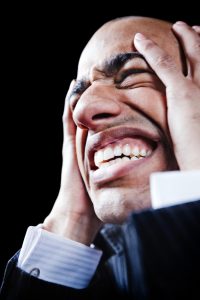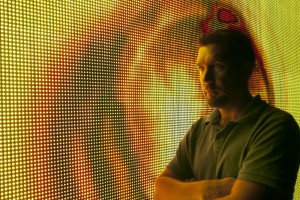Zen and the Art of Entertainment Lighting, Part 3
Posted on May 2, 2012Written by Mike Graham, product manager for CHAUVET Professional
I can remember sitting in the audience during a show on one of the ships, I was auditing. There was a banjo player on stage and he was working on creating a mood. He was trying to create the image of sitting on his grandfather’s front porch in the evening learning how to play the banjo. All of a sudden, every single moving light in the rig started doing ballyhoo. In Technicolor. It looked like a scene from Close Encounters of the Third Kind and I wanted to crawl into a hole and die. The mental image, destroyed for the audience and the banjo player was about as mad as a banjo player can get. The point is that in a situation like this, on can accomplish more with less. More often than not, this applies.
 In the above case, I have to think that the programmer simply lost their mind for a minute. Clearly, they were not thinking about the talent onstage. Or how to serve the show best. In a stage show, such as a rock concert, or even on a cruise ship, you have a ton of lights in the rig because you have to be able to create tons of different looks.
In the above case, I have to think that the programmer simply lost their mind for a minute. Clearly, they were not thinking about the talent onstage. Or how to serve the show best. In a stage show, such as a rock concert, or even on a cruise ship, you have a ton of lights in the rig because you have to be able to create tons of different looks.
A rock show is completely different from the straight play I wrote about before. One of the great things about moving lights is that you can position them wherever you want with the roll of a wheel, a slide of a fader, or a stroke of a key. The basic principles of front, side, top, down, and back lighting still apply. However, now it is ok to add in a little flavor—BUT ONLY WHEN NECESSARY. For a great lesson in this, I highly recommend checking out the U2 concert video for Rattle and Hum. Largely shot in black and white, you can clearly see how certain songs call for strong beams of light to position down onto each member of the band at certain times. The end result is absolutely stunning. Some of my favorite looks are just simple shafts of light coming from asymmetrical positions. I really like to have odd angles coming in from at least two positions. If you have good spot light operators, it is even better!

Moving lights can also lend themselves to becoming an evil temptation. Yep, they move, change color at the blink of an eye, and you can even drop in a gobo. For some programmers, this is like putting a Twinkie in front of the sound guy. Just because a light has a particular function, it does not mean you have to use it every c ue. Once I discovered the move-in-black function on the Wholehog II, it was like someone gave me the key to life. I learned how to use moving lights as a conventional light (conventional lights are lights that don’t move, have one color in them, and are focused to a specified location). Now, I could make these big “statement” looks like I saw in all of these concerts I had seen before. I was also able to effectively use the tools at hand and create a Zen-like state in my shows. It gave me the subtle lighting show that I wanted to have without having distractions. I found that I was much more at peace with the whole process once I figured out that you don’t have to overdo it.
ue. Once I discovered the move-in-black function on the Wholehog II, it was like someone gave me the key to life. I learned how to use moving lights as a conventional light (conventional lights are lights that don’t move, have one color in them, and are focused to a specified location). Now, I could make these big “statement” looks like I saw in all of these concerts I had seen before. I was also able to effectively use the tools at hand and create a Zen-like state in my shows. It gave me the subtle lighting show that I wanted to have without having distractions. I found that I was much more at peace with the whole process once I figured out that you don’t have to overdo it.
Another important part in the Zen of programming is that you, as a programmer and designer, must be in a place in your mind where you are at peace. You must be clear of mind so that you can make good choices. In order to be clear of mind, you must know what you are programming and for what type of show. Know your act and know your audience. If you are doing a Rush show, go big with big beam looks and excitement. If you are doing something that calls for an intimate design, then that is what you should do…create a mood. Becoming part of the environment is critical to this. (I am not saying to become the lights, but hey, who am I to argue if you do?) The goal should be to feel at ease with your lights. If you watch a true master of design and programming at work, it looks easy. A true Zen master will be so in-tune with what is going on around them that they are completely aware of their surroundings. For me, if I am able to, I will video tape a rehearsal and work from it. This gives me the ability to design and program without the act there if I have to. This way, I don’t have the pressure of having to rush to get my looks down. I also try to be alone. Too often, people who are “just trying to help” will really ruin your Zen thing. Turn off the cell phone, put on your headphones and get into your zone.

Keep in mind as you go, “Does this look natural?” How does the color reflect the mood of the subject? Is the lighting conveying this mood? Should this be a sharp beam effect or diffused? Does this call for a gobo breakup? Do I need a strobe light hit here? Every lighting change must be motivated. I can remember hearing over and over in acting class, “What is your motivation?” Well, what is it? Is there a change in the action that calls for you to write a cue? Did your principal actor just cross from stage right to stage left? Did your band just change tempo? Was there a murder on stage? If the answer is yes, then write a cue. If there is no change in action on stage, then there is no need. I’m sorry, but “Because it’s in the script” typically is not good enough and may need to be challenged. So challenge it. Wisely.
Now go forth, young Grasshopper, there is nothing more to teach today.
Read Zen and the Art of Entertainment Lighting, Part 2
Read Zen and the Art of Entertainment Lighting, Part 1
